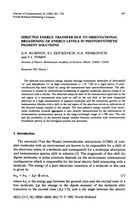| dc.contributor.author | Rubinov, A. N. | en |
| dc.contributor.author | Zenkevich, E. I. | en |
| dc.contributor.author | Nemkovich, N. A. | en |
| dc.contributor.author | Tomin, V. I. | en |
| dc.date.accessioned | 2017-05-18T13:33:40Z | |
| dc.date.available | 2017-05-18T13:33:40Z | |
| dc.date.issued | 1982 | |
| dc.identifier.citation | Directed energy transfer due to orientational broadenning of energy levels in photosynthetic pigment solutions / A. N. Rubinov [et al.] // Journal of Luminescence. – 1982. – Vol. 26, № 4. – P. 367-376. | en |
| dc.identifier.uri | https://rep.bntu.by/handle/data/30011 | |
| dc.description.abstract | The directed non-radiative energy transfer through monomeric molecules of chlorophyll “a” and pheophytin “a” at high concentrations (c ~ 10⁻²) in a rigid matrix of polyvinylbutyral has been found by using the nanosecond laser spectrofluorimeter. The phenomenon is caused by orientational broadening of pigment molecular spectra owing to its interaction with a solvent. The observed temporal shift of the luminescence spectrum to the red region in a nanosecond time scale as well as the red shift of the time integrated spectrum at a high concentration of pigment molecules and the monotonic growth of the luminescence lifetime with a shift to the red region of the spectrum served as indications of the directed energy transfer in the sample. The non-radiative energy transfer from monomeric molecules towards aggregates is also directly demonstrated by the deformation of instantaneous luminescence spectra in the long-wavelength range (λ > 700 nm). The role and the possibility of the directed energy transfer between molecules with orientationally broadened spectra in the biological systems are discussed. | ru |
| dc.language.iso | en_US | en |
| dc.title | Directed energy transfer due to orientational broadenning of energy levels in photosynthetic pigment solutions | en |
| dc.type | Article | ru |
| dc.identifier.doi | 10.1016/0022-2313(82)90065-5 | |

